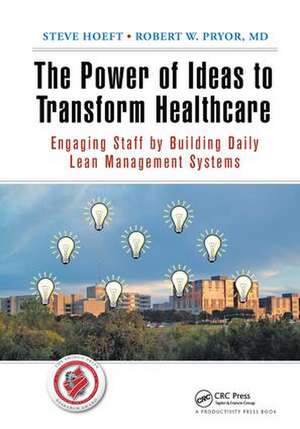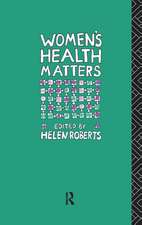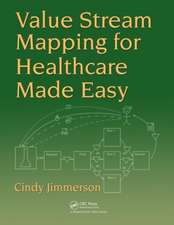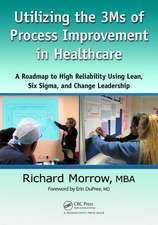The Power of Ideas to Transform Healthcare: Engaging Staff by Building Daily Lean Management Systems
Autor Steve Hoeft, Robert W. Pryor, MDen Limba Engleză Hardback – 27 iul 2017
| Toate formatele și edițiile | Preț | Express |
|---|---|---|
| Paperback (1) | 369.82 lei 6-8 săpt. | |
| Taylor & Francis – 17 iun 2015 | 369.82 lei 6-8 săpt. | |
| Hardback (1) | 986.91 lei 6-8 săpt. | |
| Taylor & Francis – 27 iul 2017 | 986.91 lei 6-8 săpt. |
Preț: 986.91 lei
Preț vechi: 1328.88 lei
-26% Nou
Puncte Express: 1480
Preț estimativ în valută:
188.84€ • 197.18$ • 155.94£
188.84€ • 197.18$ • 155.94£
Carte tipărită la comandă
Livrare economică 16-30 aprilie
Preluare comenzi: 021 569.72.76
Specificații
ISBN-13: 9781138431638
ISBN-10: 113843163X
Pagini: 422
Dimensiuni: 178 x 254 mm
Greutate: 0.45 kg
Ediția:1
Editura: Taylor & Francis
Colecția Productivity Press
Locul publicării:Oxford, United Kingdom
ISBN-10: 113843163X
Pagini: 422
Dimensiuni: 178 x 254 mm
Greutate: 0.45 kg
Ediția:1
Editura: Taylor & Francis
Colecția Productivity Press
Locul publicării:Oxford, United Kingdom
Public țintă
Professional Practice & DevelopmentRecenzii
The joint wisdom and experience of Hoeft/Pryor makes this book both fun to read and a great resource for organization leaders and internal consultants tasked with improving processes. While the fit for healthcare is obvious, the practices they have so succinctly described will benefit any workplace.
—Cindy Jimmerson, Author and Founder of Lean Healthcare West
Lean healthcare has become a buzzword and as such often gets mired in the bureaucracy of ineffective programs. Steve and Bob give us deep insight into the philosophy and thinking essential to making Lean healthcare a way of putting innovative ideas to work to achieve breakthrough performance for patients, team members, and the institution.
—Jeffrey K. Liker, Ph.D., Shingo Prize-Winning Author of The Toyota Way
This book is built upon rock-solid foundations, bringing the daily Lean management system to life through their stories and examples. Hoeft and Pryor colorfully demonstrate how staff ideas and a broader Lean management system greatly benefit patients, staff, physicians, and the health system. Lean is not just a set of tools or a series of projects, and this book is full of inspiration and practical advice for everybody who needs to participate actively in a Lean transformation, starting with the CEO and other senior leaders. This is a must-read.
—Mark Graban, Shingo Prize-Winning Author of Lean Hospitals and Co-Author of Healthcare Kaizen
... The Scott & White system, at the time this book was written, counted 2,000 implemented ideas for improvement from employees per week from their 16,000 employees, this in an environment that included recent budget and staff cuts. That number is unheard of in my experience outside of a few high volume, low variety automotive manufacturers, mainly Toyota and some of its suppliers.
That level of employee engagement is for me the sine qua non of a successful Lean implementation supported by a robust Lean management system. ... Steve Hoeft is a teacher and coach with firsthand experience in Toyota’s thinking and approach. Pryor knew the direction he wanted to go: sustained high levels of employee engagement in improving S&W’s performance. Together, they developed an approach to move in that direction. Either would tell you they’re far from done. But the distance they’ve traversed and the progress they’ve made stands as a significant achievement, chronicled in the pages that follow ... This book documents the path the authors created at Scott & White ... It’s a systematic approach, and it’s working.... It entails taking leaders through a process wherein they persuade themselves of the value of sharing, with front-line staffers, their managerial discretion to define problems worth working on. When that happens, it holds the promise to improve the entire organization’s performance in ways others will find difficult to duplicate. The goal is worthy, the journey is worth making.
—David Mann, Ph.D., Shingo Prize-Winning Author of Creating a Lean Culture, Third Edition
The Power of Ideas to Transform Healthcare is an invaluable tool for any organization seeking to align their objectives from the system level to the front line—and that should be all organizations. In it, Hoeft and Pryor describe a practical approach to developing a culture of continuous improvement by engaging employees in problem-solving and developing a management system to support it at all levels.
—Chris Van Gorder, FACHE, President and Chief Executive Officer, Scripps Health
The pursuit of Lean thinking is not a top down process, it is a way of allowing everyone to do what is best for the patient in the most effective and efficient manner. Bob and Steve’s book gives great insight on how this is done in healthcare.
—C. Courtland Huber, Ph.D., Past Director of the Executive M.B.A. Program at the McCombs School of Business, University of Texas at Austin
—Cindy Jimmerson, Author and Founder of Lean Healthcare West
Lean healthcare has become a buzzword and as such often gets mired in the bureaucracy of ineffective programs. Steve and Bob give us deep insight into the philosophy and thinking essential to making Lean healthcare a way of putting innovative ideas to work to achieve breakthrough performance for patients, team members, and the institution.
—Jeffrey K. Liker, Ph.D., Shingo Prize-Winning Author of The Toyota Way
This book is built upon rock-solid foundations, bringing the daily Lean management system to life through their stories and examples. Hoeft and Pryor colorfully demonstrate how staff ideas and a broader Lean management system greatly benefit patients, staff, physicians, and the health system. Lean is not just a set of tools or a series of projects, and this book is full of inspiration and practical advice for everybody who needs to participate actively in a Lean transformation, starting with the CEO and other senior leaders. This is a must-read.
—Mark Graban, Shingo Prize-Winning Author of Lean Hospitals and Co-Author of Healthcare Kaizen
... The Scott & White system, at the time this book was written, counted 2,000 implemented ideas for improvement from employees per week from their 16,000 employees, this in an environment that included recent budget and staff cuts. That number is unheard of in my experience outside of a few high volume, low variety automotive manufacturers, mainly Toyota and some of its suppliers.
That level of employee engagement is for me the sine qua non of a successful Lean implementation supported by a robust Lean management system. ... Steve Hoeft is a teacher and coach with firsthand experience in Toyota’s thinking and approach. Pryor knew the direction he wanted to go: sustained high levels of employee engagement in improving S&W’s performance. Together, they developed an approach to move in that direction. Either would tell you they’re far from done. But the distance they’ve traversed and the progress they’ve made stands as a significant achievement, chronicled in the pages that follow ... This book documents the path the authors created at Scott & White ... It’s a systematic approach, and it’s working.... It entails taking leaders through a process wherein they persuade themselves of the value of sharing, with front-line staffers, their managerial discretion to define problems worth working on. When that happens, it holds the promise to improve the entire organization’s performance in ways others will find difficult to duplicate. The goal is worthy, the journey is worth making.
—David Mann, Ph.D., Shingo Prize-Winning Author of Creating a Lean Culture, Third Edition
The Power of Ideas to Transform Healthcare is an invaluable tool for any organization seeking to align their objectives from the system level to the front line—and that should be all organizations. In it, Hoeft and Pryor describe a practical approach to developing a culture of continuous improvement by engaging employees in problem-solving and developing a management system to support it at all levels.
—Chris Van Gorder, FACHE, President and Chief Executive Officer, Scripps Health
The pursuit of Lean thinking is not a top down process, it is a way of allowing everyone to do what is best for the patient in the most effective and efficient manner. Bob and Steve’s book gives great insight on how this is done in healthcare.
—C. Courtland Huber, Ph.D., Past Director of the Executive M.B.A. Program at the McCombs School of Business, University of Texas at Austin
Notă biografică
Steve Hoeft, Robert W. Pryor MD
Cuprins
Introduction. Why Lean? Why Now? Philosophy. How S&W Did It—Applying TPS to Healthcare. The Huddle System (LMS)—In Detail. Tips and Techniques. Forms. Appendix: Acronyms and Terms.
Descriere
Mangroves inhabit tropical coastlines and are particularly abundant along deltas and bays where rivers bring freshwater and sediment to the sea. This habitat witnesses great variability in sedimentation and erosion rates, partly governed by variation in hydrodynamics of rivers as well as the sea. Sedimentation and hydrodynamics have a great impact on coastal and mangroves dynamics. Sediment accretion creates new mud flats for colonization whilst exposure to waves and currents may strongly hinder colonization and promote coastal erosion. In sheltered coastal bays, mangroves were able to colonize newly-formed mudflats. Abrupt high sedimentation led to vast mortality in Avicennia but it had less impact on survival and growth of Rhizophora and Sonneratia. Water turbulence had great impact on Rhizophora seedling growth and survival. In contrast, Avicennia and Sonneratia were able to survive and grow well in exposed conditions. The integrating models showed that water turbulence and seedling herbivory had the strongest impacts on mangrove colonization success.




















